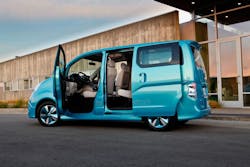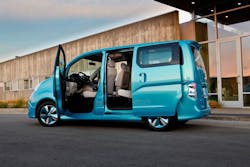The rub right now where this rulemaking effort is concerned is how much noise is too much? That’s what automakers and government officials are wrangling over at the moment.
To get an idea of just how complex this “noise-making” issue is, just read the comments submitted to the National Highway Traffic Safety Administration (NHTSA) by the Global Automakers trade group by clicking here.
Michael Cammisa, director of safety for Global Automakers, noted that while the group supports the intent of the regulation to assist pedestrians, it maintains concerns that NHTSA’s current proposal may lead to alert sounds that are “excessively and unnecessarily noisy to others” both inside and outside of the vehicle.
Here’s a little background: since 2010, industry groups, government agencies, the National Federation of the Blind, and the American Council of the Blind, have been toiling away on behalf of the Pedestrian Safety Enhancement Act (PSEA) that directed NHTSA to undertake this “noise-making” regulatory effort.
[One should note that the safety considerations at stake here are nothing to sniff at. The video below explains why.]
Simply put, this rulemaking is intended to assist pedestrians in identifying the presence of hybrid and electric vehicles (EVs) by requiring automakers to add sound to them.
That isn’t easy, though – not by a long shot – as what seems like a simple “noise emission” rule becomes significantly complicated at the vehicle engineering level.“The proposed eight one-third octave band results in alert sound specifications that are too loud and too complicated and cannot be validated in outdoor testing under the five proposed test conditions,” Cammisa (at right) noted in the Global Automakers’ comments filed with NHTSA.
“The loudness in NHTSA’s proposal is created by summing required broadband content in eight one-third octave bands when the sound in each band is already loud enough for detection purposes,” he stressed. “The resultant sum is a sound that is, at a minimum, 6 dB [decibels] louder than necessary. When a compliance margin for repeatability and reproducibility [plus] a production variation is added on, this proposed alert sound becomes 9-12 dB louder than necessary. The dB sound scale is logarithmic, so this represents a doubling in the perceived sound levels.”
It’s no wonder, then, that the Global Automakers group is working in parallel through the Society of Automotive Engineers (SAE) and the International Organization for Standardization (ISO) on the development of an engineering method for measuring the minimum sound emitted by road vehicles; an effort aimed at finding a sound hybrids and EVs can emit while travelling at low speed that pedestrians in the vicinity would be able to hear in a range of ambient environments – a sound also containing “acoustic signal content” that pedestrians will recognize as being emitted from a vehicle.
Tell you one thing; a lot of aspirin is going to be needed to quell the headaches produced by this particular vehicle engineering effort.


